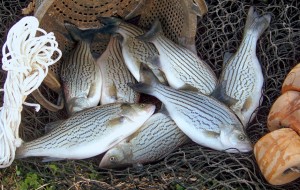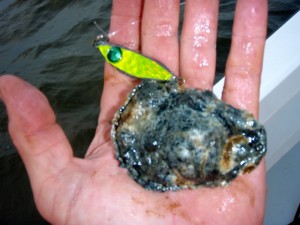aquaculture
 Number five: Aquaculture Accounts for Over FIFTY Percent of Stripers Sold – In fact, it’s closer to sixty percent. Hybrid striped bass production is one of the fastest growing forms of aquaculture in the United States. Annual production has increased over two-hundred percent in recent years as scientists refine efficient and highly productive ways to raise stripers. Commercial fishing for wild striped bass has a long history in Maryland, but don’t let anyone fool you into thinking you couldn’t eat stripers if they weren’t caught in the Chesapeake Bay. In fact, you’ll eat better if you eat farm-raised fish. Those of us who catch and eat fish right off the boat are used to great-tasting fish, but hybrid stripers have a slightly sweeter flavor and a more delicate texture than wild-caught fish. They don’t contain the high levels of mercury and PCBs found in Chesapeake Bay rockfish, so it’s safer to feed them to your family. Striped bass aquaculture is a sustainable method for providing healthy , high-quality fish to restaurants, grocery stores, and seafood markets. In stark contrast, a recent effort by the Department of Natural Resources to get wild-caught striped bass deemed sustainable in Maryland, failed. Read More!
Number five: Aquaculture Accounts for Over FIFTY Percent of Stripers Sold – In fact, it’s closer to sixty percent. Hybrid striped bass production is one of the fastest growing forms of aquaculture in the United States. Annual production has increased over two-hundred percent in recent years as scientists refine efficient and highly productive ways to raise stripers. Commercial fishing for wild striped bass has a long history in Maryland, but don’t let anyone fool you into thinking you couldn’t eat stripers if they weren’t caught in the Chesapeake Bay. In fact, you’ll eat better if you eat farm-raised fish. Those of us who catch and eat fish right off the boat are used to great-tasting fish, but hybrid stripers have a slightly sweeter flavor and a more delicate texture than wild-caught fish. They don’t contain the high levels of mercury and PCBs found in Chesapeake Bay rockfish, so it’s safer to feed them to your family. Striped bass aquaculture is a sustainable method for providing healthy , high-quality fish to restaurants, grocery stores, and seafood markets. In stark contrast, a recent effort by the Department of Natural Resources to get wild-caught striped bass deemed sustainable in Maryland, failed. Read More!
 It’s not that hard, right? You just open your mouth, close your eyes, and throw it back. At least that’s how a lot of people eat oysters. I wonder if they really like them, or just the idea of eating them? I consider myself something of an oysterholic. There’s only so long I can go without eating some. I like them just about every way you can prepare them, but especially raw. I have several friends who are also oysterholics. Since our problem is more than we can handle, we’ve developed a twelve-step-program. Thank goodness they sell oysters by the dozen!
It’s not that hard, right? You just open your mouth, close your eyes, and throw it back. At least that’s how a lot of people eat oysters. I wonder if they really like them, or just the idea of eating them? I consider myself something of an oysterholic. There’s only so long I can go without eating some. I like them just about every way you can prepare them, but especially raw. I have several friends who are also oysterholics. Since our problem is more than we can handle, we’ve developed a twelve-step-program. Thank goodness they sell oysters by the dozen!
I remember the first oyster I ever tried. It was spring break of my freshman year in college. I visited a friend who lived on a boat along the Florida coast. We were broke and hungry so he showed me how to wade out and catch oysters from the Apalachicola Bay. We shucked them with a screwdriver and ate them on the spot. They were delicious. I’ve since refined my techniques for finding and eating oysters, but I’ll never forget the first time. Read More!


